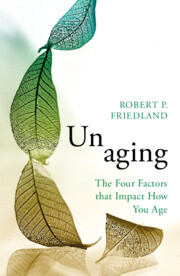Book contents
- Unaging
- Reviews
- Unaging
- Copyright page
- Dedication
- Contents
- List of Figures and Tables
- Preface
- Part I Foundations: What Do We Need to Know about Optimal Aging?
- Part II Applications: What Can We Do about the Opportunity of Aging?
- 12 Overview
- 13 Physical Activity
- 14 Whole Body Health
- 15 Mental Activity
- 16 Psychological Measures
- 17 Social Factors
- 18 Dealing with Stress
- 19 Sleep
- 20 Diet
- 21 Microbial Considerations
- 22 Dental Care
- 23 Dealing with Doctors and Drugs
- 24 Hazardous Behaviors
- 25 Toxic Exposures
- Part III Conclusions
- Acknowledgments
- Glossary
- References
- Index
21 - Microbial Considerations
from Part II - Applications: What Can We Do about the Opportunity of Aging?
Published online by Cambridge University Press: 15 September 2022
- Unaging
- Reviews
- Unaging
- Copyright page
- Dedication
- Contents
- List of Figures and Tables
- Preface
- Part I Foundations: What Do We Need to Know about Optimal Aging?
- Part II Applications: What Can We Do about the Opportunity of Aging?
- 12 Overview
- 13 Physical Activity
- 14 Whole Body Health
- 15 Mental Activity
- 16 Psychological Measures
- 17 Social Factors
- 18 Dealing with Stress
- 19 Sleep
- 20 Diet
- 21 Microbial Considerations
- 22 Dental Care
- 23 Dealing with Doctors and Drugs
- 24 Hazardous Behaviors
- 25 Toxic Exposures
- Part III Conclusions
- Acknowledgments
- Glossary
- References
- Index
Summary
Our ancestors had a vastly different diet than the one we have today. They had a much higher fiber content in their diet with less meat. This earlier human diet led to greater diversity of gut bacteria, which we now understand is important for health. Considerable research is being done worldwide about which bacterial populations will be best to consume as probiotics (live bacteria believed to aid health and enhance bacterial populations in the gut). Consumption of yogurt which has live bacteria is desirable, but don’t eat yogurt with a lot of sugar. Rather than eating yogurt with added fruit and sugar, it’s better to eat plain yogurt and add your own fruit. Prebiotics are non-digestible fibers that cannot be digested by people, which are designed for their ability to be metabolized by desirable gut bacteria. Consumption of high-fiber foods (including fruits, nuts, legumes, brown rice, beans, whole grains, vegetables, whole wheat bread) will have a similar effect on the microbiome as prebiotics. It is wise to avoid low-fiber foods such as red meat, which is high in saturated fat and provides little of the nutrition which is needed by our microbiota.
- Type
- Chapter
- Information
- UnagingThe Four Factors that Impact How You Age, pp. 246 - 248Publisher: Cambridge University PressPrint publication year: 2022

